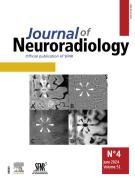Prognostic Implications of Intracranial Haemorrhage on Dual-Energy CT Immediately Following Endovascular Treatment for Acute Ischemic Stroke - 19/11/23
 , Magretha M.Q. Robbe 1, 2, Susanne G.H. Olthuis 2, 3, Hieronymus D. Boogaarts 4, Wim H. van Zwam 1, 2, Robert J. van Oostenbrugge 2, 3, Alida A. Postma 1, 5
, Magretha M.Q. Robbe 1, 2, Susanne G.H. Olthuis 2, 3, Hieronymus D. Boogaarts 4, Wim H. van Zwam 1, 2, Robert J. van Oostenbrugge 2, 3, Alida A. Postma 1, 5Cet article a été publié dans un numéro de la revue, cliquez ici pour y accéder
ABSTRACT |
Objective |
To describe the incidence, risk factors, and prognostic relevance of intracranial haemorrhage (ICH) immediately after endovascular treatment (EVT) for ischemic stroke in the anterior circulation.
Methods |
EVT records from 2010-2019 were screened. Included patients underwent DECT within 3h post-EVT. Virtual native reconstructions were evaluated for ICH according to the Heidelberg criteria and grouped into Heidelberg classes (HCs): [HC1] haemorrhagic infarction (HI)1, HI2 and parenchymal haematoma (PH)1; [HC2] PH2; [HC3] i.a. intraventricular and subarachnoid haemorrhage. If ICH corresponding to multiple HCs was observed, we assumed that the (largest) parenchymal ICH would have the greatest prognostic impact. Hence, a single HC was attributed by the following order of severity: HC2, HC1, HC3. The primary outcome was the modified Rankin Scale (mRS) at 90 days. The effect of asymptomatic ICH (aICH) and symptomatic ICH (sICH) of (1) HC1 or HC2 and (2) HC3 on patient outcomes was evaluated with multivariable regression after multiple imputation.
Results |
Out of 651 records, 498 patients were included. Eighty-one (16%) patients showed ICH on post-EVT DECT, of which 19 were classified as HC1 (21% symptomatic), 6 as HC2 (100% symptomatic), and 56 as HC3 (14% symptomatic). ICH development was mainly associated with unfavourable procedural characteristics. Both aICH and sICH of HC1 or HC2 were associated with the mRS (aICH: adjusted [a]cOR 4.92, 95%CI [1.48-16.35]; sICH: acOR 12.97, 95%CI [2.39-70.26]) and mortality (aICH: aOR 10.08, 95%CI [2.48-40.88]; sICH: aOR 9.92, 95%CI [1.48-66.31]). Likewise, sICH of HC3 was associated with the mRS and mortality (acOR 19.91, 95%CI [4.03-98.35], and aOR 13.23, 95%CI [2.27-77.18], respectively). aICH of HC3 was not significantly associated with the mRS or mortality (acOR 0.87, 95%CI [0.48-1.57], and cOR 0.84, 95%CI [0.32-2.20], respectively).
Conclusions |
Immediate post-EVT ICH is a frequent finding. Except for aICH of HC3, any ICH is associated with poor long-term clinical outcomes.
Le texte complet de cet article est disponible en PDF.Graphical Abstract |
Keywords : dual-energy CT, intracranial hemorrhages, ischemic stroke, thrombectomy, prognosis
Abbreviations : AIS, aICH, ASPECTS, BBBD, DECT, eTICI, EVT, HI, ICA, ICA-T, ICH, IV, IVH, M1/M2, mRS, NCCT, NIHSS, PH, rPH, SAH, sICH, VNC
Plan
| Statement of ethics approval This study was approved by the ethics committee of the Maastricht University Medical Centre+, Maastricht, The Netherlands (MEC-2020-1456). The need for individual patient consent has been waived. |
|
| Disclosures H.D. Boogaarts received consultation fees from Stryker Neurovascular (paid to the institution). W.H. van Zwam received consultation fees from Stryker, Nicolab and Cerenovus (paid to the institution), and is a DSMB member of the Philips’ We-Trust study, Anaconda's Solonda study, and In Extremis study (all funding paid to the institution). A.A. Postma received an institutional grant from Siemens Healthineers and Bayer Healthcare. |
Bienvenue sur EM-consulte, la référence des professionnels de santé.
L’accès au texte intégral de cet article nécessite un abonnement.
Déjà abonné à cette revue ?

